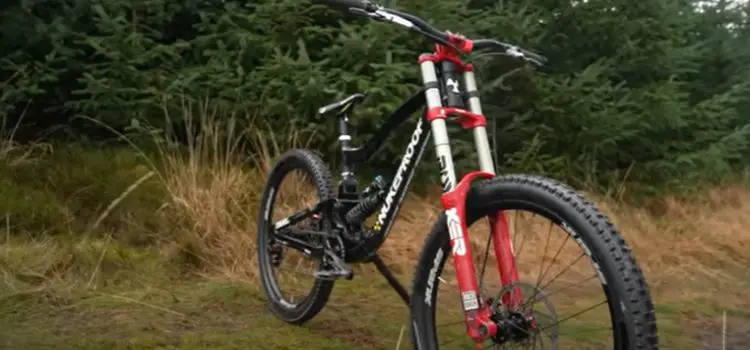Can You Ride a Mountain Bike on Pavement?
As an Amazon Associate I earn from qualifying purchases.
The question of whether you can ride a mountain bike on pavement is one that often arises among cycling enthusiasts. The short answer is yes, you can ride a mountain bike on pavement, but it comes with its own set of challenges and considerations.
Let’s delve into the dynamics of using a mountain bike on smooth surfaces and explore the various aspects that riders should take into account.

Understanding the divide
Understanding the divide between mountain bikes and pavement is fundamental to grasping the challenges and dynamics involved in riding a mountain bike on smooth surfaces. At its core, this dichotomy stems from the distinct design philosophies embedded in these two categories of bicycles.
Mountain bikes, engineered for the rugged outdoors, are characterized by robust frames, durable components, and an aggressive stance. These bikes are equipped with wide, knobby tires that offer superior traction on uneven terrain, enabling riders to tackle steep inclines, navigate rocky trails, and traverse unpredictable landscapes with ease. Additionally, mountain bikes often feature advanced suspension systems, absorbing shocks and ensuring a smoother ride when confronted with bumps and obstacles.
On the contrary, road bikes are crafted for the precise demands of paved surfaces. They showcase lightweight frames, slim tires with minimal tread, and aerodynamic designs optimized for speed on smooth roads. Road bikes prioritize efficiency and agility, making them the preferred choice for cyclists covering long distances on well-maintained highways.
This divide becomes evident when a mountain bike is introduced to pavement. The knobby tires, designed for grip on loose terrain, can result in increased resistance and a less efficient ride on smooth roads. The robust suspension systems, a boon in off-road situations, might absorb energy that could otherwise contribute to forward motion. Recognizing and navigating these differences is essential for cyclists seeking to blend the worlds of mountain biking and pavement exploration, paving the way for informed modifications and an enhanced riding experience.
Challenges of Riding a Mountain Bike on Pavement
Riding a mountain bike on pavement, while possible, presents a set of challenges that riders should be aware of to make informed decisions about their cycling experience. Here are some key challenges associated with using a mountain bike on smooth surfaces:
1. Tire Design and Rolling Resistance
Mountain bike tires are designed with a large and knobbly tread pattern, optimized for grip on off-road terrain. However, on pavement, this type of tire can lead to increased rolling resistance. The pronounced knobs, instead of providing smooth traction, create more friction with the road, making the ride less efficient.
2. Suspension Systems and Energy Loss
Many mountain bikes are equipped with suspension systems designed to absorb shocks on rugged trails. While beneficial in off-road scenarios, these suspension systems can absorb pedal energy on pavement. This results in a loss of efficiency as energy that could contribute to forward motion gets dissipated into the suspension system, making the ride less responsive.
3. Weight and Geometry
Mountain bikes are generally heavier than road bikes due to their sturdy frames and components built for durability on challenging terrain. This additional weight can make it more labor-intensive to pedal on smooth pavement. The geometry of mountain bikes, optimized for stability on uneven surfaces, may also contribute to a less agile and slower experience on the road.
4. Limited Aerodynamics
The aerodynamic design of road bikes is specifically crafted for speed on smooth surfaces. Mountain bikes, with their more upright riding position and bulkier frame, lack the streamlined characteristics that contribute to efficient aerodynamics. This can result in increased air resistance, making it harder to maintain higher speeds on pavement.
5. Less Efficient Transmission of Power
Mountain bikes are built to handle challenging terrain where efficiency may not be the top priority. On pavement, the less efficient transmission of power from the rider to the wheels can result in a slower and more strenuous ride compared to purpose-built road bikes.
6. Handling and Maneuverability
The handling and maneuverability of mountain bikes, while excellent on trails, may not translate seamlessly to the quick turns and precise maneuvers often required on pavement. The bike’s responsiveness may be compromised, impacting the overall riding experience on smooth roads.
7. Uneven Tire Wear
The knobbly design of mountain bike tires, while providing excellent grip off-road, may result in uneven tire wear on pavement. This uneven wear can lead to a smoother patch down the center of the tire, affecting both traction and overall performance.
Understanding these challenges is crucial for cyclists looking to ride their mountain bikes on pavement. While these obstacles exist, many riders find the adaptability and versatility of mountain bikes make them a viable choice for diverse terrains with the right adjustments and modifications.
Modifications for a Smoother Ride on Pavement
To transform a mountain bike into a more pavement-friendly machine and ensure a smoother ride on smooth surfaces, several modifications can be implemented. These adjustments aim to enhance efficiency, reduce rolling resistance, and optimize the bike’s performance for a more comfortable experience on pavement. Here are key modifications for a smoother ride:
1. Smaller slick tires
Swapping out the standard knobby mountain bike tires for smaller, slick ones is a significant modification. Slick tires with a smoother tread pattern reduce rolling resistance, providing better efficiency and a smoother ride on pavement. The decreased surface area in contact with the road minimizes friction, allowing the bike to glide more easily.
2. Locking out the suspension
Many modern mountain bikes come equipped with suspension systems. Utilizing the suspension lockout feature, if available, prevents unnecessary energy loss. Locking out the suspension for pavement rides ensures that more pedal power is directly transferred to the wheels, improving overall efficiency and responsiveness.
3. Running with higher tire pressure
Adjusting tire pressure is crucial for optimizing a mountain bike for pavement. Running at a higher tire pressure than what is typically used for off-road trails reduces rolling resistance. This modification helps the bike roll more smoothly on the road, making the ride more comfortable and efficient.
4. Handlebar and Riding Position
Experimenting with handlebar styles and adjusting the riding position can contribute to a smoother ride. While mountain bikes typically come with flat handlebars, some riders may find that adopting a more aerodynamic riding position, similar to road bikes, improves efficiency on pavement.
5. Gearing Adjustments
Fine-tuning the bike’s gearing for pavement riding is essential. While mountain bikes often feature a wide range of gears suitable for various terrains, adjusting the gearing for higher speeds on roads can optimize the bike for smoother rides. This ensures that the cyclist can maintain comfortable speeds on flat surfaces.
6. Lightweight Components
Upgrading certain components to lighter alternatives can contribute to an overall reduction in weight. While mountain bikes are designed for durability, shedding some weight can enhance the bike’s efficiency on pavement. Components such as the saddle, pedals, or even the frame can be considered for upgrades.
7. Aerodynamic Accessories
Adding aerodynamic accessories, such as aero bars or streamlined water bottle holders, can contribute to reducing air resistance. While not as crucial as on a road bike, these accessories can enhance the bike’s aerodynamics and improve overall efficiency on pavement.
8. Balancing Comfort and Efficiency
Finding the right balance between comfort and efficiency is key. While optimizing the bike for pavement, cyclists should consider their own preferences and riding style. Adjustments such as saddle height, handlebar positioning, and overall bike fit play a role in achieving a smoother and more enjoyable ride.
Implementing these modifications can transform a mountain bike into a more versatile and pavement-friendly ride, offering cyclists the opportunity to enjoy the best of both worlds: the ruggedness of off-road trails and the smoothness of urban or suburban roads.
Reasons for Riding a Mountain Bike on Pavement
Despite the challenges, many cyclists opt to ride mountain bikes on pavement for various reasons, including:
- Comfort:
- Mountain bikes often provide a more comfortable riding position and sturdier frame, appealing to those prioritizing comfort.
- Versatility:
- The ability to seamlessly transition from pavement to off-road trails offers a versatile riding experience.
- Handlebar Preference:
- Some riders prefer the flat handlebars found on mountain bikes over the drop bars commonly seen on road bikes.
Conclusion
In conclusion, while mountain bikes are not optimized for pavement, riders can certainly adapt and enjoy them on smooth surfaces with the right modifications.
Swapping tires, adjusting suspension, and optimizing components can bridge the gap between off-road and on-road cycling. Whether it’s the thrill of exploring diverse terrains or the comfort and versatility offered by mountain bikes, riders can find joy in the unique experience of riding them on pavement.
Amazon and the Amazon logo are trademarks of Amazon.com, Inc, or its affiliates.






